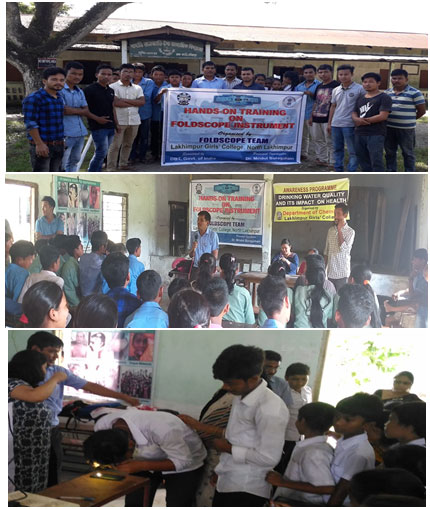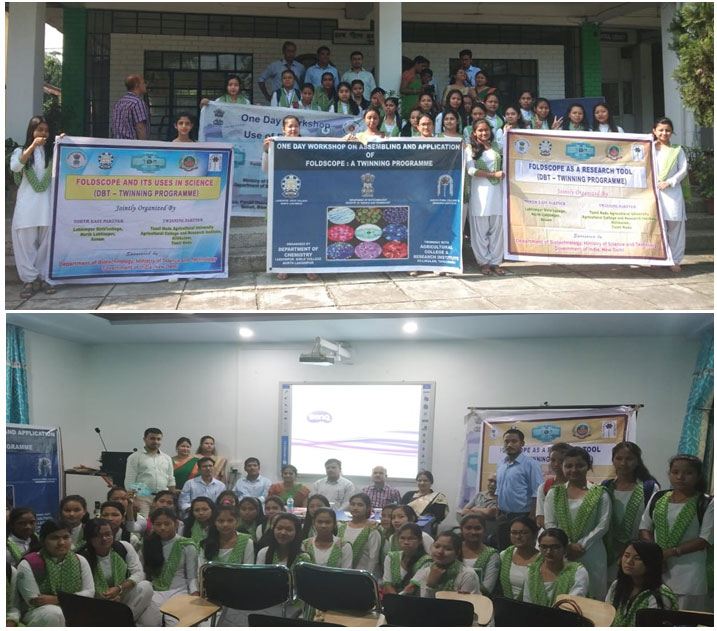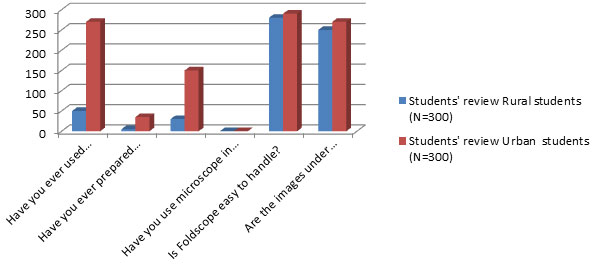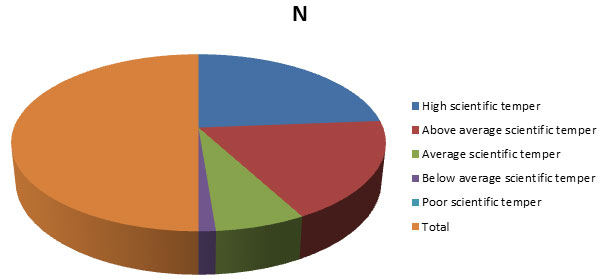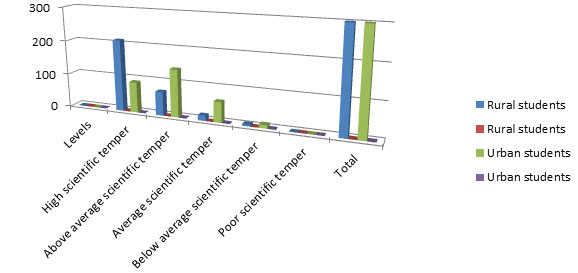1Department of Chemistry, Lakhimpur Girls’ College, North Lakhimpur, Assam, India and
2Post Graduate Training College, Dhemaji, Assam, India
Corresponding author email: mridulnlp2019@gmail.com
Article Publishing History
Received: 30/10/2020
Accepted After Revision: 10/12/2020
It is impossible to identify various microorganisms present in our local environment at the spot without sampling in laboratory. The Foldscope is an origami portable, optical and affordable microscope which is more comfortable than the conventional microscope for field studies. Moreover, it can be used as a high-end frugal technology for teaching science. The exposure of students to Foldscope in biology courses could channel student’s interest towards further experimental activity and original research. This study aims to explore the usability of the foldscope in science classroom and additionally in their projects and field survey as per their syllabus. For this study 600 students (300 from rural and 300 from urban) were selected randomly as sample from 30 secondary schools (15 from rural and 15 from urban) in Lakhimpur district of Assam.
A comparison on utilizing scientific temper in the experiments was made between the schools of urban and rural areas. Workshops cum handling sessions were successfully conducted among both the teachers and students. Water samples including, bacteria, algae and insects body parts were observed by the students. Statistical analysis of the data in respect of different dimensions of scientific temper such as curiosity, open-mindness, objectivity, rationality, aversion to superstition was also performed for both rural and urban secondary school students and the result showed that the students of rural schools were more curious, logistic and interactive regarding the instrument. This study was, in short, quite successful in approving our predetermined results. The concept of ‘aversion to superstition’ was fulfilling enough to apply.
Foldscope, Scientific Temper, Secondary Students.
Kakoti N, Buragohain M, Buragohain I. Utility of Foldscope in Promoting Scientific Temper by Igniting the Mind: A Study among Rural and Urban Senior Secondary School Learners. Biosc.Biotech.Res.Comm. 2020;13(4).
Kakoti N, Buragohain M, Buragohain I. Utility of Foldscope in Promoting Scientific Temper by Igniting the Mind: A Study among Rural and Urban Senior Secondary School Learners. Biosc.Biotech.Res.Comm. 2020;13(4). Available from: https://bit.ly/392wCUQ
Copyright © Kakoti et al., This is an Open Access Article distributed under the Terms of the Creative Commons Attribution License (CC-BY) https://creativecommons.org/licenses/by/4.0/, which permits unrestricted use distribution and reproduction in any medium, provide the original author and source are credited.
INTRODUCTION
Education and Research is nowadays a term up solution that sound to resolve any impact to the well being. Adequate research and tools are now a synchronized matter of concern in this scientific world. To bring up the socio-economic development and awareness education is only the key to drive a society. Development of technology, pedagogy, and content knowledge with respect to science teachers shows a manageable contact among the teachers and students (Guzey et al., 2009). In India the government schools have been affected in their education process due to lack of well-equipped infrastructure (Lahon, 2015). To cope up with a vast of knowledge practical rather than theory is easier to devour but is complexed in our system (India) due to lack of skilled teachers, well equipped infrastructure and technologies (Kro, 2017). A recent investigation report that a new way of teaching learning procedure is equipped by online interactions, group conference and projects that develops a framed knowledge in better understanding among the students (Tal et al., 2018).
Mobile has also been a tremendous device in learning process that seems to provide awareness, conservation of samples and even statistical analysis (Kissi et al., 2018). Microscopic world proves to be an elevated level of interest in science. The best effort of understanding biological science is the use of lens and resolution that provides an image beyond its imagination. Students and teachers are found to be more interactive and engaged in their experiment, by the use of microscope in classrooms. Visual information provides a quick action in student’s brain, helping to memorize the facts and figures. Fast learning of biological science is more motivational by hands on training, collection of samples, preparations of slides, questioning and discussions (Mirko et al., 2018).
A study in various schools in Split-Dalmatia Country reported that 53% teachers used microscope for quality teaching of biological experiments while the rest have a reason of insufficient availability of microscope, lack of space and trained teachers (Mirko et al., 2018). Student positive reviews show a graceful advantage of using foldscope in government and private schools in understanding the biological experiments (Das et al., 2019). Morphological and characterization of fungal pathogens in tea leaves of Sikkim were also being observed. Different crucial stages of the malaria parasite Plasmodium falciparum was lucratively identified under the foldscope. Students mind seems to be full of curiosity (Wangdi et al., 2019; Shailaja et al., 2019).
Scientific temper promotes a handful understanding beyond in experiments of the subjects enhancing logic, interactions, observations and open mindness (Thakur et al., 2019). An interesting throw in Genetics to study the growth stages and mutants in Drosophila under foldscope proves a majestic success in both schools and colleges. This study mainly focused on the handling and use of foldscope in schools and colleges of Lakhimpur district, Assam. Workshop cum handling session was successfully conducted among both teachers and students. Students were allowed to carry the foldscope to the field work for observations of samples including water bacteria, algae, plant cells and different body parts of insects and images were stored in smart phones (Walling et al., 2020). Observation of bacteria in water samples including E. coli, Acinetobacter were also done by the college students as per their project work in the end semester.
MATERIAL AND METHODS
The Foldscope is an ultra-design origami microscope (Fig 1) signifying the conventional microscopes, can be carried to harsh field conditions which can be affordable by schools and colleges for biological experiments (Cybulski et al., 2014). This origami instrument is extensively used for the purpose of fieldwork in Sandy Hook New Jersey. Different water and sand samples were observed and images are been stored in smartphones (Bazler et al., 2016). It can be assembled from a punched sheet of cardstock, a spherical glass lens, a light emitting diode and a diffuser panel, along with a watch battery that powers the LED. The use of foldscope by students is bearable due to less cost, non breakable and easy to handle. The foldscope can be used by the student of any age to visualize the samples and is phone fitted (Buragohain et al., 2019).
Figure 1: The Foldscope
The study area for research, Lakhimpur district (Fig 2) lies on the North East corner of Assam and at the North Bank of the mighty river Brahmaputra. The district lies between 27.597′ Northern latitude and 94.737′ Eastern longitude and covers an area of 2277 Sq km (Statistical Hand Book, 2017). For this study 600 students (300 from rural and 300 from urban) were selected randomly as sample from 30 secondary schools (15 from rural and 15 from urban) in the study area.
The objective of this study had been formulated to explore the use of foldscope in the education institutions of the study area, to study the various dimensions of scientific temper of rural and urban secondary school students and their comparative study. For the preparation of sample, students were allowed to carry the foldscope in the fields survey for collection of samples and prepare the slides at instant. The visualization of the samples was observed and pictures were also stored in smart phones by the teachers (Buragohain et al., 2019).
Figure 2: A cross sectional view of the study area
RESULTS AND DISCUSSION
Various organized workshops on hands-on-training and handling sessions regarding applications of foldscope were successfully conducted in different educational institutes among the students and the teachers (Fig 3a – 3e).
Figure 3a: Workshop on handling of foldscope in Asian Public School, North Lakhimpur
Figure 3b: Workshop on handling of foldscope in Genius Academy, North Lakhimpur
Figure 3c: Workshop on handling of foldscope in Laluk H.S. School, Laluk
Figure 3d: Workshop on handling of foldscope in Bodoti Jamuguri Janajati High School, Bihpuria
Figure 3e: Workshop on handling of foldscope in Lakhimpur Girls’ College, North Lakhimpur
The slides for foldscopic images of isolated bacteria were prepared by simple staining for selected colonies. On the basis of cell wall composition to differentiate the bacteria whether it belongs to Gram positive or Gram negative, Gram’s staining was done (Fig 4a) and the visualization of clinical isolates under foldscope was done (Fig 4b). Bacterial cultures were observed to find gram negative and gram positive bacteria by performing staining at various time intervals. The slide was placed in the paper based microscope interfaced with a mobile phone. After staining the cells were observed under foldscope and recorded the images for further analysis (Fig 4c).
Figure 4a: Microbial growth on nutrient agar plates
Figure 4b: Visualization of clinical isolates under foldscope
Figure 4c: Gram staining observation of bacteria in water samples through foldscope (Magnification: 140 X)
Analysis of Questionnaires:
Table 1. Overall students’ review on the use of foldscope
| Questions | Students’ review | |
| Rural students (N=300) | Urban students (N=300) | |
| Have you ever used microscope? | 50 | 270 |
| Have you ever prepared slides? | 5 | 35 |
| Have you visited fields for sample collection? | 30 | 150 |
| Have you use microscope in field survey? | 0 | 0 |
| Is Foldscope easy to handle? | 280 | 290 |
| Are the images under foldscope clear? | 250 | 270 |
Table 2. Overall percentage of scientific temper among secondary school students
| Levels | N | % age |
| High scientific temper | 285 | 47.50 % |
| Above average scientific temper | 220 | 36.67 % |
| Average scientific temper | 80 | 13.33 % |
| Below average scientific temper | 15 | 2.50 % |
| Poor scientific temper | 0 | 0.00 % |
| Total | 600 | 100.00% |
The study showed that 47.50 % secondary school students have high level of scientific temper, 36.67 % secondary school students have above average level of scientific temper, 13.33 % have average level of scientific temper, only 2.50 % have below average level of scientific temper and none were having poor level of scientific temper (Fig 5 and Fig 6).
Figure 5: Overall students’ review on the use of foldscope
Figure 6: Overall percentage of scientific temper among secondary school students
Table 3. Comparison between rural and urban students on levels of scientific temper
| Levels | Rural students | Urban students | ||
| N | Percentage | N | Percentage | |
| High scientific temper | 210 | 70.00 % | 90 | 30.00 % |
| Above average scientific temper | 70 | 23.33 % | 140 | 46.67 % |
| Average scientific temper | 15 | 5.00 % | 60 | 20.00 % |
| Below average scientific temper | 5 | 1.67 % | 10 | 3.33 % |
| Poor scientific temper | 0 | 0.00 % | 0 | 0.00 % |
| Total | 300 | 100.00 % | 300 | 100.00 % |
The table 3 revealed that rural secondary school students show more level of ‘High scientific temper’ (70.00%) as compared to urban secondary school students (30.00%). It further depicts that about 46.67% of urban secondary school student showed ‘Above average scientific temper’ while 23.33% of rural secondary students fall at this level. Further, 20.00% of urban secondary students fall at ‘Average scientific temper’ while only 5.00% of rural student showed ‘Average scientific temper’. In rural secondary school, 1.67% of the student showed ‘Below average scientific temper’ while in urban area, 3.33% of the secondary school student showed ‘Below average scientific temper’ (Fig 7) (Buragohain et al., 2019).
Figure 7: Comparison between rural and urban students on levels of scientific temper
Table 4. Mean comparison between rural and urban students on ‘Curiosity’ dimension of scientific temper (N=300 each)
| Dimension | Group | Mean | Std. Deviation | t-value | Level of
Significance |
| Curiosity | Rural | 8.95 | 1.252 | 7.634 | ** |
| Urban | 6.80 | 1.925 |
**=significant at 0.01
The table 4 showed the mean difference between rural and urban secondary school students on ‘Curiosity’ dimension of scientific temper scale. The table revealed that there was significant difference between rural and urban secondary school students on curiosity dimension. The calculated t-value 7.634 exceeded the tabulation value at 0.01 level of significance. This justified that the difference between two groups was statistically significant at 0.01 level. Further the mean score of rural (8.95) secondary school students is decidedly better than the mean score of urban (6.80) secondary school students (Thakur et al., 2019).
Table 5. Mean difference between rural and urban students on ‘open-mindness’ dimension of scientific temper (N=300 each)
| Dimension | Group | Mean | Std. Deviation | t-value | Level of
Significance |
|
Open-mindness |
Rural | 7.45 | 1.535 |
7.842 |
** |
| Urban | 5.65 | 2.157 |
**=significant at 0.01
The table 5 showed the mean difference between rural and urban secondary school students on ‘open-mindness’ dimension of scientific temper. The table reveals that there was significant difference between the rural and urban secondary school students on open-mindness dimension of scientific temper. The calculated t-value of 7.842 exceeded the tabulation value at 0.01level of significance. Further, the mean score of rural (7.45) secondary school students was higher than the mean of urban (5.65) secondary school students. (Thakur et al., 2019).
Table 6. Mean difference between rural and urban students on ‘objectivity’ dimension of scientific temper (N=300 each)
| Dimension | Group | Mean | Std. Deviation | t-value | Level of
Significance |
| Objectivity | Rural | 9.02 | 1.187 | 8.450 |
** |
| Urban | 7.85 | 1.970 |
**=significant at 0.01
The table 6 showed the mean difference between rural and urban secondary school students on ‘Objectivity’ dimension of scientific temper. The table revealed that there was significant difference between the rural and urban secondary school students on ‘Objectivity’ dimension of scientific temper. The calculated t-value of 8.450 exceeded the tabulation value at 0.01level of significance. Further, the mean favored rural (9.02) secondary school student, which implied that rural students are more open to new things than urban secondary school students (Buragohain et al., 2019).
Table 7. Mean difference between rural and urban students on ‘Rationality’ dimension of scientific temper (N=300 each)
|
Dimension |
Group |
Mean |
Std. Deviation |
t-value |
Level of Significance |
| Rationality | Rural | 8.27 | 1.235 | 10.485 | ** |
| Urban | 6.02 | 1.910 |
**=significant at 0.01
The table 7 revealed that there was significant difference between rural and urban secondary school students on ‘Rationality’ dimension of scientific temper. The calculated t-value of 10.485 exceeds the tabulation value at 0.01level of significance. This justified that the difference between the two groups (rural & urban) was statistically significant at 0.01. The mean of rural (8.27) secondary school students is decidedly more than urban (6.02) secondary school students, which indicated that rural students were more rational, reasonable, and highbrowed than urban (Buragohain et al., 2019).
Table 8. Mean difference between rural and urban students on ‘Aversion to superstition’ dimension of scientific temper (N=300 each)
| Dimension | Group | Mean | Std.
Deviation |
t-value | Level of
Significance |
|
Aversion to superstition |
Rural | 5.85 | 1.610 |
5.285 |
** |
| Urban | 4.97 | 2.127 |
**=significant at 0.01
The table 8 showed the mean difference between rural and urban secondary school students on ‘Aversion to superstition’ dimension of scientific temper. The table revealed that there was significant difference between the rural and urban secondary school students on this dimension of scientific temper at 0.01level. Further, the mean score favoured the rural (5.85) secondary school students, which implies that rural secondary school students did not follow any belief blindly (Thakur et al., 2019).
Table 9. Mean difference between rural and urban students on ‘Overall dimensions’ of scientific temper (N=300 each)
| Dimension | Group | Mean | Std. Deviation | t-value | Level of
Significance |
| Scientific temper | Rural | 39.12 | 4.017 | 11.455 | ** |
| Urban | 31.85 | 7.015 |
**=significant at 0.01
The table 9 revealed that rural and urban secondary school students differ significantly on composite score of scientific temper scale. The calculated t-value of 11.455 exceeded the tabulation value at 0.01level of significance. This justified that the difference is statistically significant at 0.01. Further, the mean of rural (39.12) secondary school students is better than the mean score of urban (31.85), which indicates that rural secondary school students displayed better scientific temper than urban secondary school students (Thakur et al., 2019).
CONCLUSION
The foldscope instrument is affordably designed to be carried in every student’s pocket. Being an effective research tool it helps mainly in the field visits to observe the samples at instant. The smart phones is an another valuable tool to fit with for storing a particular sample image. An interacting relation between the teachers and students about the images of samples was also seen. The foldscope has proved to be a valuable diagnostic tool for the secondary school students that lack space and expenditure. Findings revealed that there was significant difference between rural and urban secondary school students on curiosity. Rural students are found to be more curious to learn new things and are always ready to go for any adventure trips.
Further, the findings depicted that rural and urban secondary school students differ significantly on open-mindness, objectivity, and rationality dimension of scientific temper. Findings shown that rural secondary school students are open to new things. They do not reject any knowledge which conflict with their own idea. Their mind is free from any prejudice and is unbiased. Rural students are inclined to interpret the data prior to the actual observations and experimentation that was made as well as verifies the observation’s consistency. The study showed that rural secondary school students were high on ‘aversion to superstition’ dimension of scientific temper than their counterparts. They rejected the false beliefs and accept scientific facts and explanations.
ACKNOWLEDGEMENTS
This research was supported by a grant from Department of Bio Technology (DBT), Govt. of India, New Delhi in the form of Major Research Project vide no. BT/IN/INDO-US/FOLDSCOPE/39/2015, dated 20th March, 2018. We are thankful to Mr. Bhaba Kr. Pegu, Ms. Puja Sarmah and Mr. Suman Raj Mahanta for their helping hands in organising different workshops. We are also thankful to Dibrugarh University, for providing the research facility.
Conflict of Interest: On behalf of all authors, the corresponding author states that there is no conflict of interest.
REFERENCES
Bazler, J.A., VanSickle, M. and Engstrom, C. (2016). The Foldscope. Journal of Modern Education Review. 6 (1), pp.118-124
Buragohain, M., Kakoti, N., Sarmah, P. and Pegu, K. B. (2019). Foldscope as a diagnostic tool: A case study in Lakhimpur district of Assam. Journal of Chemical, Biological and Physical Sciences. DOI: 10.24214/jcbps.D.9.2.17379. 9 (1), pp.173-179
Cybulski, J.S., Clements, J. and Prakash, M. (2014). Foldscope: Origami-Based Paper Microscope. Plos One, 9(6), pp.1-11
Das, K., Dutta, P. and Gogoi, J. (2019). Foldscope -A simple and economical microscope being used for demonstrating school level practical cum awareness on its utility as a research tool in Government and Private schools of Kamrup District, Assam, Journal of Biological Education, pp.1-10
Guzey, S.S. and Roehrig, H.G. (2009). Teaching Science with Technology: Case Studies of Science Teachers’ Development of Technology, Pedagogy, and Content Knowledge. Technology and Teacher Education. Volume 09, pp. 25-45
Kissi, L. and Dreesmann, D. (2018). Plant visibility through mobile learning? Implementation and evaluation of an interactive Flower Hunt in a botanic garden. Journal of Biological Education. 52(4), pp. 344-363
Kro, M.S. (2017). Present Education System and Its Impact on the Economically Backward Students in Assam. International Journal of Research Granthaalayah, pp. 196-201
Lahon, S. (2015). A study of infrastructure facilities in secondary schools of Assam state with special reference to Sivasagar district. Abhinav National Monthly Referred Journal of Research in Arts & Education, 4(8)
Mirko, R., Antonio, V., Goran, K. and Damir, S. (2018). The use of microscope in school biology teaching. Resolution and Discovery, DOI: 10.1556/2051.2018.00054. 3(1), pp. 1-4
Shailaja, M., Jolitha, A.B., Divya, G. E., Ranjitha Preethi, R. A., Neelima, G. M. and Suneetha, P. (2019). Malaria parasite detection-Employability of foldscope in malarial diagnosis. International Journal of Advanced Research in Biological Sciences. 6(2), pp. 248-255
Statistical Hand Book (2017). Directorate of Economics and Statistics. Govt. of Assam, Guwahati-28
Tal, T. and Tsaushu, M. (2018). Student-centered introductory biology course: evidence for deep learning. Journal of Biological Education. 52(1), pp. 376-390
Thakur, U. and Bhan, R. (2019). Scientific Temper among Secondary School Students with Respect to Their Gender. International Journal of Science and Research (IJSR).8(11), pp. 815-817
Walling, B., Neikh, K., Thepa, A., Jamir. N. and Yenisetti, C. S. (2020). Utility of Foldscope in Classroom Teaching of Genetics, Research Gate.
Wangdi, P. L., Pradhan, A. and Mangar, S. (2019). Foldscope as a research tool in the diagnosis of fungal leaf spot diseases in Sikkim, Research communication, pp.1-4






